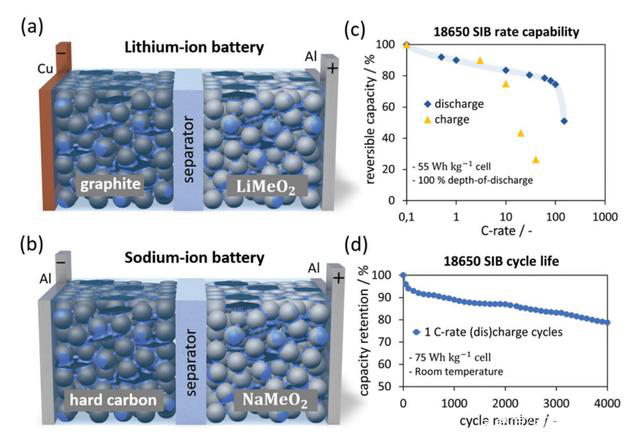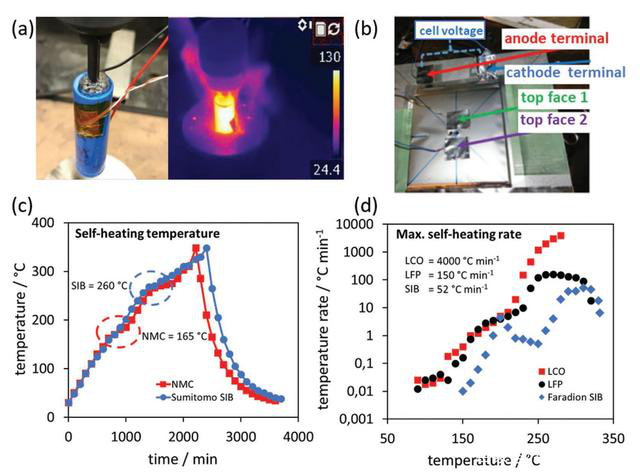Comparison of Lithium Ion Batteries and Sodium Ion Batteries

1.Battery design differences
There is almost no difference in battery design between lithium ion batteries and sodium ion batteries. The slurry formulation design, electrode production process and battery assembly process are all the same. The only difference between the two is that the negative electrode of the lithium ion battery uses Cu foil as the current collector , The positive electrode uses Al foil as the current collector, this is mainly because Al will form an alloy with Li, resulting in the powdering of the Al foil. However, there is no such problem in sodium ion batteries. Therefore, aluminum foil can be used as the current collector for both the positive and negative electrodes of sodium ion batteries, which is beneficial to reduce cost and battery weight. This design also brings an advantage: sodium ion batteries can Discharge to 0V for safe storage without worrying about the degradation caused by oxidation of the negative electrode copper foil.
Electrolyte design In terms of electrolyte design, lithium-ion batteries and sodium-ion batteries are basically the same, and the same solvent can be used. The main difference between the two is reflected in the choice of salt. In the lithium-ion battery electrolyte, lithium hexafluorophosphate is mainly used. , And sodium hexafluorophosphate is mainly used in sodium ion batteries. But at present, high-purity sodium hexafluorophosphate has a significant advantage in price, which is only about 1/4 of the price of high-purity lithium hexafluorophosphate.
2. Energy density, power and cycle performance of the battery
At present, the development of sodium ion batteries is still in the early stage, so the energy density still has a relatively large gap compared with lithium ion batteries. The energy density of 18650 sodium ion batteries is about 90Wh/kg, and the energy density of soft package sodium ion batteries About 130-150Wh/kg. Sodium-ion batteries are basically equivalent to lithium-ion batteries in power performance, and in some cases, even slightly better than lithium-ion batteries. In terms of cycle performance, sodium ion batteries also perform well. As shown in Figure d above, the 75Wh/kg sodium ion battery has a cycle life of about 4000 times, which exceeds that of conventional lithium ion batteries.
3.security
Sodium ion batteries also have good safety performance. For example, the 18650 sodium ion battery in the figure a below can reach the maximum 130°C after 10 minutes under the condition of top acupuncture. The soft-pack sodium ion battery shown in the figure b below can also achieve no fire and no explosion during acupuncture. In the ARC test in the figure c below, the self-heating starting temperature of the lithium-ion battery is 165℃, while the sodium-ion battery reaches 260℃. In the ARC test of the lithium-ion battery shown in figure d, the sodium-ion battery’s The maximum self-heating rate is significantly lower than that of lithium-ion batteries, which indicates that sodium-ion batteries have better thermal stability.

4. cost
Low cost is a major selling point of sodium-ion batteries. Calculations show that if the negative electrode of sodium-ion batteries has the same performance and cost as lithium-ion batteries, the overall cost of sodium-ion batteries can be reduced by about 12.5%. However, in fact, the cost of hard carbon materials used in the negative electrode of sodium ion batteries is significantly higher than that of graphite materials. Therefore, according to the existing positive and negative electrode materials of sodium ion batteries, the cost of sodium ion batteries is about 329$/kWh. At present, the cost of lithium-ion batteries has approached 100$/kWh, so there is still a lot of work to be done on the cost of sodium-ion batteries.
5.Application of sodium ion battery in power battery and energy storage
For the application of power batteries, the volume energy density is more critical. The current volume energy density of sodium ion batteries is about 400Wh/L, while the current volume energy density of lithium ion batteries can reach about 700Wh/L, so sodium ion batteries are Electric vehicles do not yet have the strength to compete with lithium-ion batteries, but they can be considered for low-speed electric vehicles with lower energy density requirements. The energy storage field has relatively low requirements for the weight and volume of batteries, so this field is the main field of sodium-ion battery applications.
In general, although sodium ion batteries have a certain price advantage compared to lithium ion batteries in theory, the cost of sodium ion batteries is much higher than lithium ion batteries due to the limitation of the material cost used in sodium ion batteries. Ion batteries, but with the development and maturity of sodium ion battery material technology, the cost of sodium ion batteries will gradually decrease, and it is expected to partially replace lithium ion batteries in fields such as energy storage.
High quality graphite manufacturer
If you need graphite powder, please feel free to contact: sales@graphite-corp.com







